Canada Digital Transformation Market Size
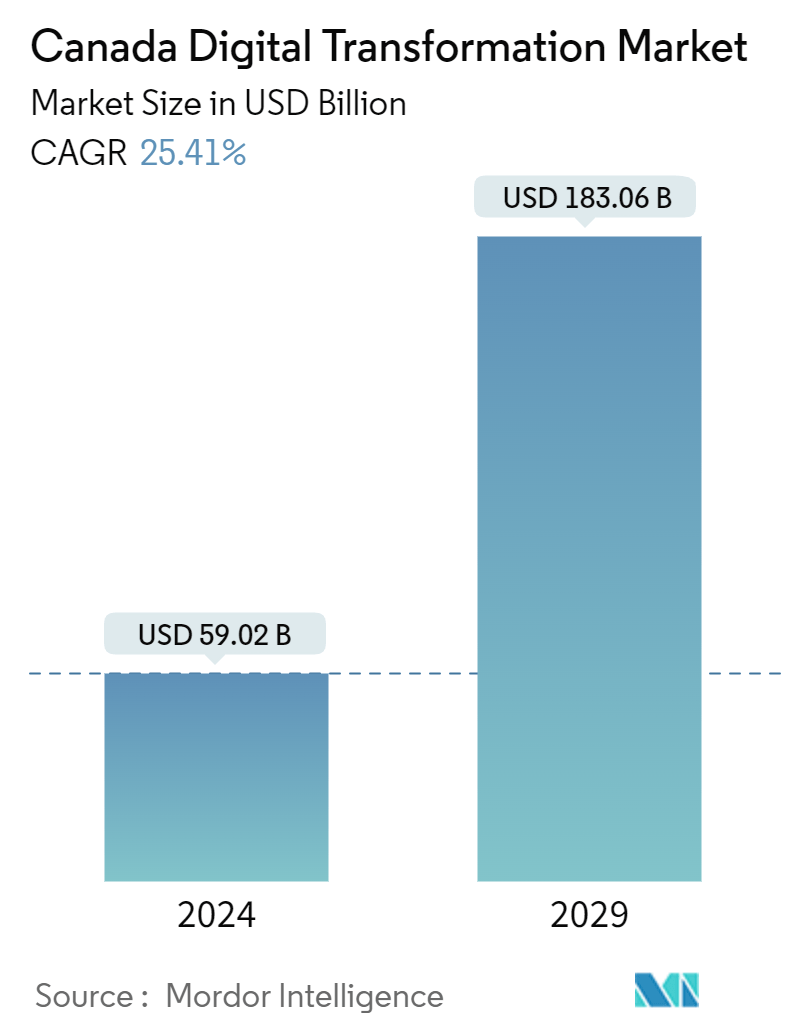
| Study Period | 2019 - 2029 |
| Base Year For Estimation | 2023 |
| Market Size (2024) | USD 59.02 Billion |
| Market Size (2029) | USD 183.06 Billion |
| CAGR (2024 - 2029) | 25.41 % |
| Market Concentration | Low |
Major Players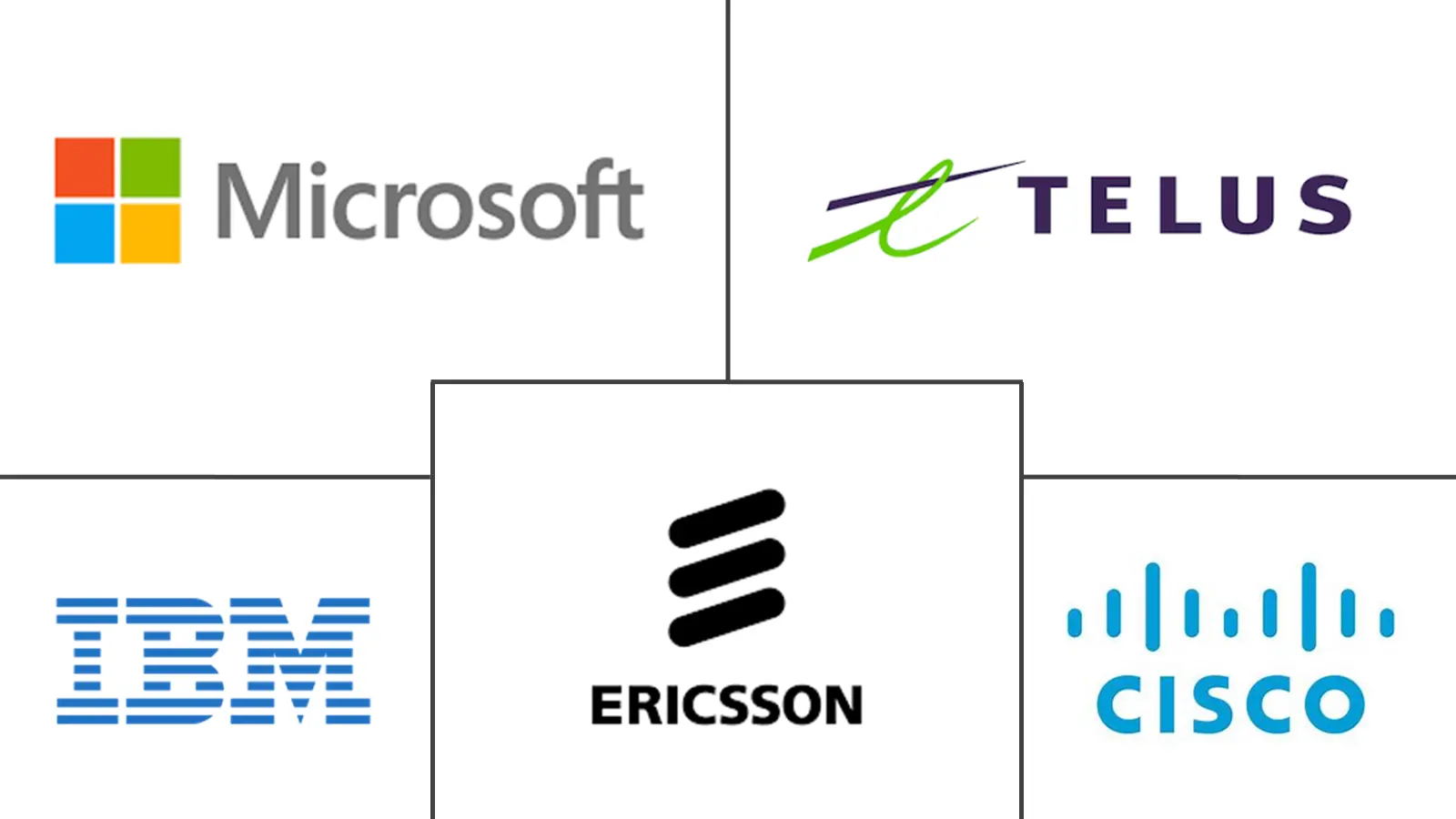
*Disclaimer: Major Players sorted in no particular order |
Canada Digital Transformation Market Analysis
The Canada Digital Transformation Market size is estimated at USD 59.02 billion in 2024, and is expected to reach USD 183.06 billion by 2029, growing at a CAGR of 25.41% during the forecast period (2024-2029).
- Canada's digital transformation is driven by adopting emerging technologies, developing innovative business models, and focusing on collaboration and innovation. The Canadian government has set ambitious targets, such as creating a "digital nation" and adopting a digital charter. These initiatives are expected to spur further investment in digital infrastructure and the adoption of new technologies.
- Artificial intelligence (AI) is a major technological advancement in the present era. It offers substantial potential for economic growth, significant productivity improvements, and new opportunities across industries in the country. In June 2024, the government announced the Consultation on Artificial Intelligence (AI) Compute, which will help inform the design and implementation of a new AI Compute Access Fund and a Canadian AI Sovereign Compute Strategy proposed in Budget 2024. The consultation includes the AI Blueprint, a discussion paper that outlines Canada’s opportunity and ambition on AI.
- IoT devices, such as smart sensors and connected devices, are set to transform industries like manufacturing, transportation, and logistics. This transformation is expected to drive increased investment in digital infrastructure and the creation of new business models.
- Moreover, Canada's information and communications technologies (ICT) industry has experienced steady and significant growth over the years. In 2023, revenues in the ICT sector reached CAD 270 billion, reflecting a substantial increase from CAD 206.8 billion in 2018. This growth highlights the sector's expanding influence and its critical role in the Canadian economy, which is expected to drive digitalization needs across the country.
- However, Canada is experiencing a significant shortage of digital skills, causing many businesses to struggle to find qualified professionals for digital roles. This gap hampers Canada's ability to compete in the global digital economy.
Canada Digital Transformation Market Trends
Cybersecurity is Expected to Drive the Market Growth
- Canada is actively embracing advanced technologies, such as 5G, to enhance its networking infrastructure. This shift is propelling digitalization on a broader scale, amplifying data processing capabilities and, consequently, the associated vulnerabilities. Consequently, the market has seen a surge in new entrants, catering to businesses of all sizes.
- The Canadian government has taken significant steps to enhance the nation's cybersecurity capabilities. These efforts encompass investments, revised regulations to aid businesses in digital transformation, and a host of other initiatives aimed at fortifying Canada's cybersecurity landscape. In May 2024. the Canadian government launched its first-ever cybersecurity strategy to address challenges posed by remote work, cloud computing, aging infrastructure, and recruitment. Additionally, the government plans to establish a security operations center (SOC) to monitor on-site, cloud, and network-connected devices across departments and agencies.
- The Canadian Anti-Fraud Centre reported over 150,000 cases of fraud in Canada since January 2021, resulting in approximately USD 600 million in losses. In 2023, the Centre received 63,519 reports from 41,988 victims, leading to losses of USD 569 million. These incidents spanned cybercrimes like malware and ransomware attacks, phishing scams, and data breaches. The repercussions have reverberated across businesses, government entities, and individuals grappling with the fallout of fraud and identity theft.
- According to SurfShark, Canada experienced numerous data breaches affecting internet users from 2004 to January 2024. Passwords were the most frequently compromised data, followed by usernames. Password hashes were the third most commonly breached data type. These significant breaches expose users' critical information, resulting in substantial losses and compromising data privacy. Advanced cybersecurity solutions can effectively prevent such incidents.
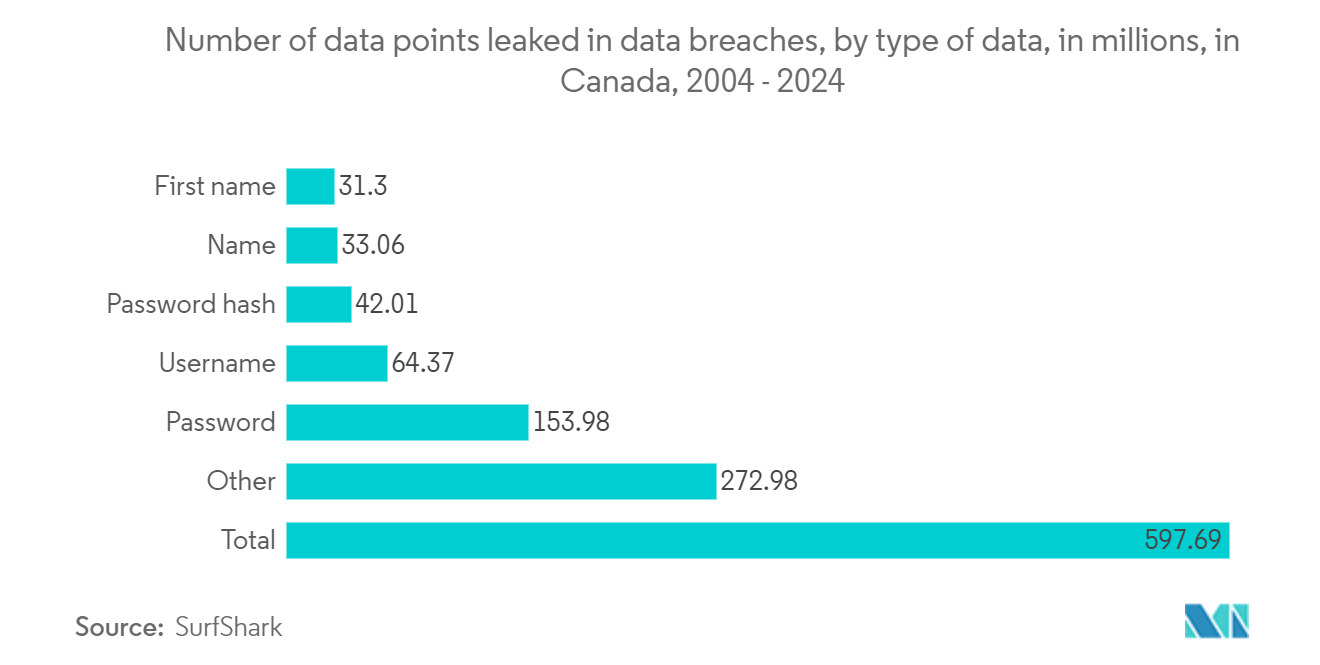
IT and Telecom Sector is Expected to Witness Major Growth
- 5G technology is set to drive industry digitalization, create new value across industries and society, and have a direct economic impact on the ICT sector. It will also integrate with advanced solutions like augmented reality, the Internet of Things (IoT), and Artificial Intelligence (AI). To harness the benefits of 5G, players in the region are launching new 5G services.
- For instance, according to GSMA, by 2025, 5G connections are expected to account for 49% of all mobile connections in Canada. All telecommunication providers are rolling out 5G networks nationwide to offer better network services to their clients and maximize the technology's potential.
- According to the Canadian Wireless Telecommunications Association (CWTA)/Accenture report, the introduction of 5G networks and services in Canada by 2026 will boost GDP by an additional USD 40 billion and create 250,000 long-term jobs. However, this advancement will cost wireless carriers approximately USD 26 billion. Significant investments by Canadian facilities-based carriers highlight the nation's ambition to establish itself as a significant player in wireless technology.
- According to Salesforce, in Canada, the proportion of revenue for business-to-business (B2B) entities generated through digital channels rose from 32% in 2021 to 42% in 2023. This trend is set to persist, with digital channels forecasted to contribute 53% of the revenue by 2025.
- In January 2024, Ericsson and Canadian telecom firm Telus partnered to roll out and enhance Telus's 5G Standalone (5G SA) network on a national scale. The advanced network, powered by Ericsson's cloud-native, dual-mode 5G core solution, will enable a range of advanced 5G services. Telus's 5G SA network will drive innovation across Canada, from supporting autonomous vehicles to improving public safety and healthcare technologies.
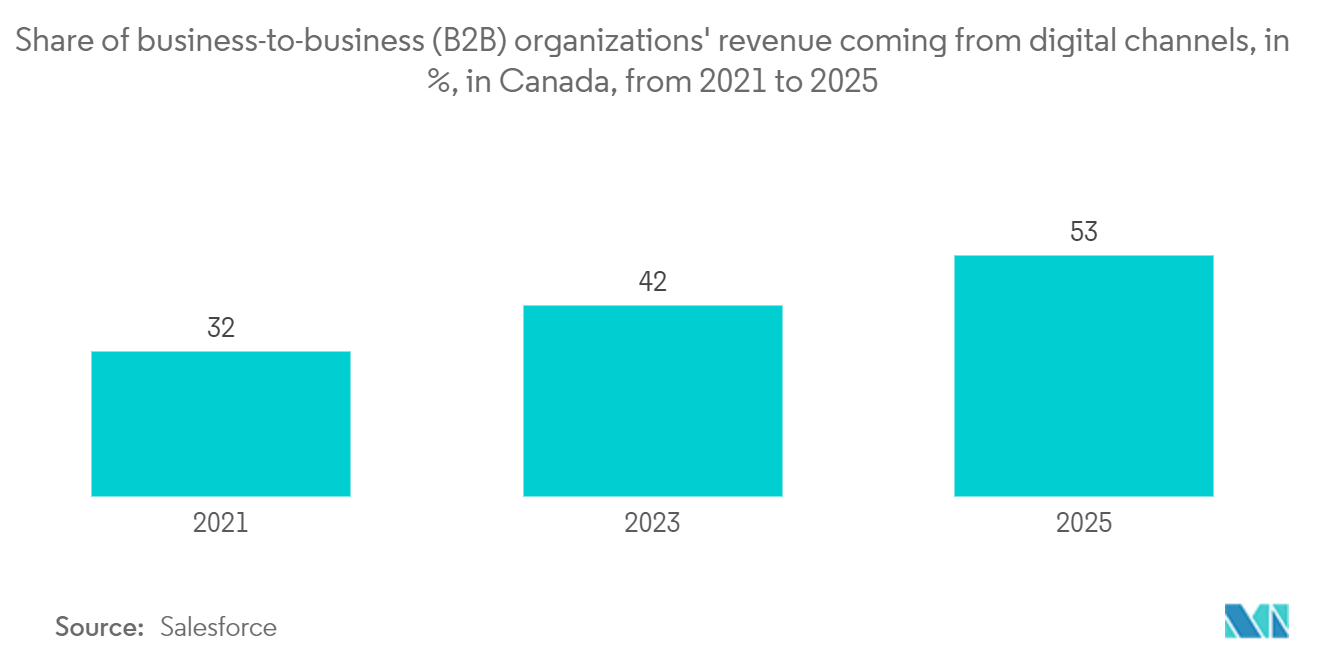
Canada Digital Transformation Industry Overview
Canada's Digital Transformation Market is highly competitive due to the presence of many players. Major players in Canada's Digital Transformation market are actively pursuing advancements. Some of the prominent companies are collaborating and expanding their footprints in the country to consolidate their positions. IBM Corporation, Microsoft Corporation, and Telefonaktiebolaget LM Ericsson are some of the major players in the market.
- April 2024: IBM launched its strategy to establish a new Cloud Multizone Region (MZR) in Montreal, Quebec. This initiative aims to assist clients in adapting to changing regulatory demands. The facility will use a secured enterprise cloud platform to harness advanced technologies, such as Generative AI. The Montreal MZR will be comprised of three Availability Zones, isolated locations within a data center or cloud infrastructure, that are designed to provide availability, consistent cloud services, and greater resiliency to help clients run mission-critical workloads.
- April 2024: Telehouse, a prominent global provider of colocation data center services, launched Telehouse Canada to equip Canadian enterprises with enhanced IT infrastructure and connectivity, essential for driving growth and fostering innovation in Canada. Telehouse Canada is poised to address the escalating need for robust colocation services, advanced digital connectivity, and the facilitation of High-Performance Computing.
Canada Digital Transformation Market Leaders
-
IBM Corporation
-
Telefonaktiebolaget LM Ericsson
-
Microsoft Corporation
-
Telus Corporation
-
Cisco Systems, Inc.
*Disclaimer: Major Players sorted in no particular order
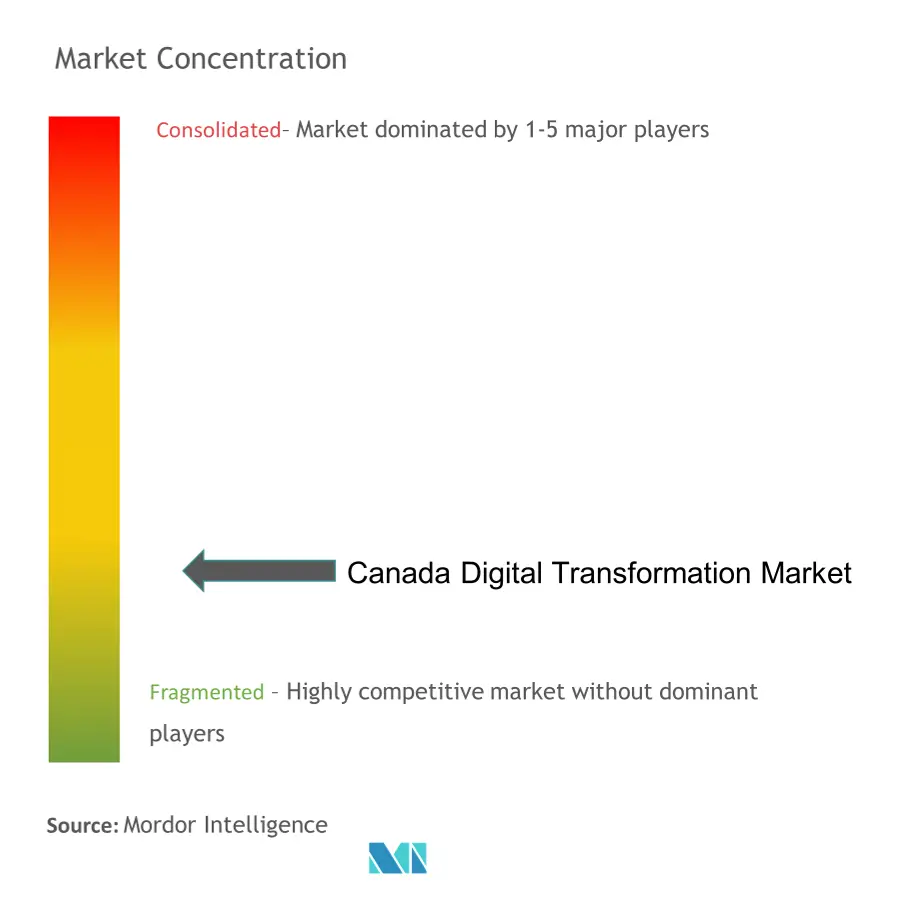
Canada Digital Transformation Market News
- July 2024: GetWireless announced an expansion of its operations into the Canadian market. The company is set to distribute its full range of IoT products and services to an extended network of resale partners and network operators in Canada.
- June 2024: Kyndryl, an IT infrastructure services provider, announced an extended partnership with the National Bank of Canada to accelerate its digital transformation and cloud migration. The partnership aims to streamline workloads and operations, reduce technical debt, and drive innovation across the organization.
Canada Digital Transformation Market Report - Table of Contents
1. INTRODUCTION
- 1.1 Study Assumptions and Market Definition
- 1.2 Scope of the Study
2. RESEARCH METHODOLOGY
3. EXECUTIVE SUMMARY
- 3.1 INDUSTRY ECOSYSTEM ANALYSIS (Detailed Coverage of Key Stakeholders in Digital Transformation Industry Product/Solution Providers, System Integrators/VARs, Connectivity Providers, Regulatory Bodies, End-users, Service Providers, etc.)
4. MARKET DYNAMICS
-
4.1 Market Drivers
- 4.1.1 Increase in the Adoption of Big Data Analytics and Other Technologies in the Country
- 4.1.2 The Rapid Proliferation of Mobile Devices and Apps
-
4.2 Market Restraints
- 4.2.1 Concerns About the Privacy and Security of Information
5. CURRENT MARKET SCENARIO AND EVOLUTION OF DIGITAL TRANSFORMATION PRACTICES
6. KEY METRICS
- 6.1 Technology Spending Trends
- 6.2 Number of IoT Devices
- 6.3 Total Cyberattacks
- 6.4 Technology Staffing Trends
- 6.5 Internet growth and penetration in the country
- 6.6 Digital Competitiveness Ranking
- 6.7 fixed and mobile broadband coverage
- 6.8 Cloud adoption
- 6.9 AI adoption
- 6.10 E-commerce penetration
7. MARKET SEGMENTATION
-
7.1 By Type
- 7.1.1 Analytics, Artificial Intelligence and Machine Learning
- 7.1.1.1 Current Market Scenario and Market Projections for the Forecast Period
- 7.1.1.2 Key Growth Influencers (Drivers, Challenges, and Opportunities)
- 7.1.1.3 Use Case Analysis
- 7.1.1.4 Market Outlook
- 7.1.2 Extended Reality (XR)
- 7.1.2.1 Current Market Scenario and Market Projections for the Forecast Period
- 7.1.2.2 Key Growth Influencers (Drivers, Challenges, and Opportunities)
- 7.1.2.3 Use Case Analysis
- 7.1.2.4 Market Outlook
- 7.1.3 IoT
- 7.1.3.1 Current Market Scenario and Market Projections for the Forecast Period
- 7.1.3.2 Key Growth Influencers (Drivers, Challenges, and Opportunities)
- 7.1.3.3 Use Case Analysis
- 7.1.3.4 Market Outlook
- 7.1.4 Industrial Robotics
- 7.1.4.1 Current Market Scenario and Market Projections for the Forecast Period
- 7.1.4.2 Key Growth Influencers (Drivers, Challenges, and Opportunities)
- 7.1.4.3 Use Case Analysis
- 7.1.4.4 Market Outlook
- 7.1.5 Blockchain
- 7.1.5.1 Current Market Scenario and Market Projections for the Forecast Period
- 7.1.5.2 Key Growth Influencers (Drivers, Challenges, and Opportunities)
- 7.1.5.3 Market Outlook
- 7.1.6 Additive Manufacturing/3D Printing
- 7.1.6.1 Current Market Scenario and Market Projections for the Forecast Period
- 7.1.6.2 Key Growth Influencers (Drivers, Challenges, and Opportunities)
- 7.1.6.3 Use Case Analysis
- 7.1.6.4 Market Outlook
- 7.1.7 Cybersecurity
- 7.1.7.1 Current Market Scenario and Market Projections for the Forecast Period
- 7.1.7.2 Key Growth Influencers (Drivers, Challenges, and Opportunities)
- 7.1.7.3 Use Case Analysis
- 7.1.7.4 Market Outlook
- 7.1.8 Cloud Edge Computing
- 7.1.8.1 Current Market Scenario and Market Projections for the Forecast Period
- 7.1.8.2 Key Growth Influencers (Drivers, Challenges, and Opportunities)
- 7.1.8.3 Use Case Analysis
- 7.1.8.4 Market Outlook
- 7.1.9 Others (digital twin, mobility and connectivity)
- 7.1.9.1 Current Market Scenario and Market Projections for the Forecast Period
- 7.1.9.2 Key Growth Influencers (Drivers, Challenges, and Opportunities)
- 7.1.9.3 Market Breakdown by Type (Digital Twin, Mobility and Connectivity)
- 7.1.9.4 Use Case Analysis
- 7.1.9.5 Market Outlook
-
7.2 By End-user Industry
- 7.2.1 Manufacturing
- 7.2.2 Oil, Gas, and Utilities
- 7.2.3 Retail & e-commerce
- 7.2.4 Transportation and Logistics
- 7.2.5 Healthcare
- 7.2.6 BFSI
- 7.2.7 Telecom and IT
- 7.2.8 Government and Public Sector
- 7.2.9 Other End-user Industries (Education, Media & Entertainment, Environment etc)
8. COMPETITIVE LANDSCAPE
-
8.1 Company Profiles*
- 8.1.1 IBM Corporation
- 8.1.2 Telefonaktiebolaget LM Ericsson
- 8.1.3 Microsoft Corporation
- 8.1.4 Telus Corporation
- 8.1.5 Cisco Systems, Inc.
- 8.1.6 Cloudoft
- 8.1.7 Next Big Technology (NBT)
- 8.1.8 Accenture PLC
- 8.1.9 Oracle Corporation
- 8.1.10 Google LLC (Alphabet Inc.)
- 8.1.11 Magneto IT Solutions
9. KEY TRANSFORMATIVE TECHNOLOGIES
- 9.1 Quantum Computing
- 9.2 Manufacturing as a Service (MaaS)
- 9.3 Cognitive Process Automation
- 9.4 Nanotechnology
Canada Digital Transformation Industry Segmentation
Digital transformation leverages digital technologies such as artificial intelligence and machine learning, extended reality (XR) for industrial applications, and IoT, among others, to create new business processes or modify existing ones, reshape organizational culture, and enhance customer experiences.
Canada's digital transformation market is segmented by type (analytics, artificial intelligence, and machine learning, extended reality (XR), IoT, industrial robotics, blockchain, additive manufacturing/3D printing, cyber security, cloud edge computing, and others (digital twin, mobility and connectivity), end-user industry (manufacturing, oil, gas, and utilities, retail & e-commerce, transportation and logistics, healthcare, BFSI, telecom and IT, government and public sector, and Other End-user Industries (Education, Media & Entertainment, Environment etc)). The market sizes and forecasts are provided in terms of value in (USD) for all the above segments.
| By Type | Analytics, Artificial Intelligence and Machine Learning | Current Market Scenario and Market Projections for the Forecast Period |
| Key Growth Influencers (Drivers, Challenges, and Opportunities) | ||
| Use Case Analysis | ||
| Market Outlook | ||
| By Type | Extended Reality (XR) | Current Market Scenario and Market Projections for the Forecast Period |
| Key Growth Influencers (Drivers, Challenges, and Opportunities) | ||
| Use Case Analysis | ||
| Market Outlook | ||
| By Type | IoT | Current Market Scenario and Market Projections for the Forecast Period |
| Key Growth Influencers (Drivers, Challenges, and Opportunities) | ||
| Use Case Analysis | ||
| Market Outlook | ||
| By Type | Industrial Robotics | Current Market Scenario and Market Projections for the Forecast Period |
| Key Growth Influencers (Drivers, Challenges, and Opportunities) | ||
| Use Case Analysis | ||
| Market Outlook | ||
| By Type | Blockchain | Current Market Scenario and Market Projections for the Forecast Period |
| Key Growth Influencers (Drivers, Challenges, and Opportunities) | ||
| Market Outlook | ||
| By Type | Additive Manufacturing/3D Printing | Current Market Scenario and Market Projections for the Forecast Period |
| Key Growth Influencers (Drivers, Challenges, and Opportunities) | ||
| Use Case Analysis | ||
| Market Outlook | ||
| By Type | Cybersecurity | Current Market Scenario and Market Projections for the Forecast Period |
| Key Growth Influencers (Drivers, Challenges, and Opportunities) | ||
| Use Case Analysis | ||
| Market Outlook | ||
| By Type | Cloud Edge Computing | Current Market Scenario and Market Projections for the Forecast Period |
| Key Growth Influencers (Drivers, Challenges, and Opportunities) | ||
| Use Case Analysis | ||
| Market Outlook | ||
| By Type | Others (digital twin, mobility and connectivity) | Current Market Scenario and Market Projections for the Forecast Period |
| Key Growth Influencers (Drivers, Challenges, and Opportunities) | ||
| Market Breakdown by Type (Digital Twin, Mobility and Connectivity) | ||
| Use Case Analysis | ||
| Market Outlook | ||
| By End-user Industry | Manufacturing | |
| Oil, Gas, and Utilities | ||
| Retail & e-commerce | ||
| Transportation and Logistics | ||
| Healthcare | ||
| BFSI | ||
| Telecom and IT | ||
| Government and Public Sector | ||
| Other End-user Industries (Education, Media & Entertainment, Environment etc) |
Canada Digital Transformation Market Research FAQs
How big is the Canada Digital Transformation Market?
The Canada Digital Transformation Market size is expected to reach USD 59.02 billion in 2024 and grow at a CAGR of 25.41% to reach USD 183.06 billion by 2029.
What is the current Canada Digital Transformation Market size?
In 2024, the Canada Digital Transformation Market size is expected to reach USD 59.02 billion.
Who are the key players in Canada Digital Transformation Market?
IBM Corporation, Telefonaktiebolaget LM Ericsson, Microsoft Corporation, Telus Corporation and Cisco Systems, Inc. are the major companies operating in the Canada Digital Transformation Market.
What years does this Canada Digital Transformation Market cover, and what was the market size in 2023?
In 2023, the Canada Digital Transformation Market size was estimated at USD 44.02 billion. The report covers the Canada Digital Transformation Market historical market size for years: 2019, 2020, 2021, 2022 and 2023. The report also forecasts the Canada Digital Transformation Market size for years: 2024, 2025, 2026, 2027, 2028 and 2029.
Canada Digital Transformation Industry Report
Statistics for the 2024 Canada Digital Transformation market share, size and revenue growth rate, created by Mordor Intelligence™ Industry Reports. Canada Digital Transformation analysis includes a market forecast outlook for 2024 to 2029 and historical overview. Get a sample of this industry analysis as a free report PDF download.



